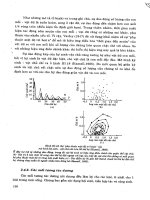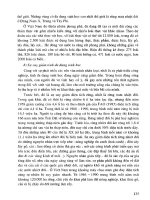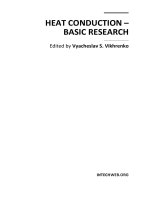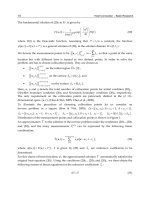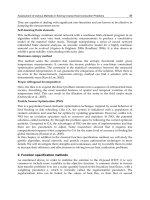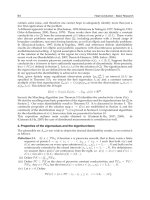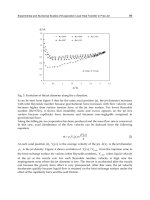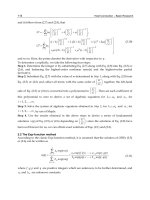Heat Conduction Basic Research Part 6 potx
Bạn đang xem bản rút gọn của tài liệu. Xem và tải ngay bản đầy đủ của tài liệu tại đây (381.83 KB, 25 trang )
Heat Conduction – Basic Research
114
and it follows from (2.7) and (2.8), that
11
1
21
2
12
1
2
'''
,
'' '
(1) (21) ( 2)
''
(2 1) ( 1)
iii
m
i
i
ii i
m
i
ii
i
GGG
Ui
GGG
GG G
iii
GG G
Ui
GG
ii
GG
(2.10)
and so on. Here, the prime denotes the derivative with respective to
.
To determine u explicitly, we take the following four steps:
Step 1. Determine the integer m by substituting Eq. (2.7) along with Eq. (2.8) into Eq. (2.5) or
(2.6), and balancing the highest-order nonlinear term(s) and the highest-order partial
derivative.
Step 2. Substitute Eq. (2.7) with the value of m determined in Step 1, along with Eq. (2.8) into
Eq. (2.5) or (2.6) and collect all terms with the same order of
'G
G
together; the left-hand
side of Eq. (2.5) or (2.6) is converted into a polynomial in
'G
G
. Then set each coefficient of
this polynomial to zero to derive a set of algebraic equations for
0
,,kc
and
i
, for
1, 2, ,im
.
Step 3. Solve the system of algebraic equations obtained in Step 2, for
0
,,kc
and
i
, for
1, 2, ,im
, by use of Maple.
Step 4. Use the results obtained in the above steps to derive a series of fundamental
solutions
()u
of Eq. (2.5) or (2.6) depending on
'G
G
; since the solutions of Eq. (2.8) have
been well known for us, we can obtain exact solutions of Eqs. (2.1) and (2.2).
2.2 The Exp-function method
According to the classic Exp-function method, it is assumed that the solution of ODEs (2.5)
or (2.6) can be written as
exp( )
exp( ) exp( )
() ,
exp( ) exp( )
exp( )
g
n
nf f g
q
pq
m
mp
an
af a g
u
bp b q
bm
(2.11)
where
,,
f
gpand
q
are positive integers which are unknown, to be further determined, and
n
a and
m
b are unknown constants.
Exact Travelling Wave Solutions for
Generalized Forms of the Nonlinear Heat Conduction Equation
115
3. A generalized form of the nonlinear heat conduction equation
3.1 Application of the (G'/G)-expansion method
Introducing a complex variable
defined as Eq. (2.3), Eq. (1.1) becomes an ordinary
differential equation, which can be written as
2
() 0, 0
nn
kcU ak U U U a
(3.1)
or, equivalently,
22221
(1) 0,
nnn
kcU aknn U U aknU U U U
(3.2)
To get a closed-form analytic solution, we use the transformation (Kabir & Khajeh, 2009;
Wazwaz, 2005)
1
1
() (),
n
UV
(3.3)
which will convert Eq. (3.2) into
2 2 2 2 23 22
(1) (12) (1) (1) (1) 0,kc n V V ak n n V ak n n VV n V n V
(3.4)
According to Step 1, considering the homogeneous balance between
VV
and
2
VV
in Eq.
(3.4) gives
2231,mm
(3.5)
so that
1.m
(3.6)
Suppose that the solutions of (3.4) can be expressed by a polynomial in
'G
G
as follows:
01 1
'
() , 0.
G
V
G
(3.7)
where
0
and
1
, are constants which are unknown, to be determined later.
Substituting Eq. (3.7) along with Eq. (2.8) into Eq. (3.4) and collecting all terms with the same
power of
'G
G
together, the left-hand side of Eq. (3.4) is converted into a polynomial in
'G
G
. Equating each coefficient of this polynomial to zero yields a set of simultaneous
algebraic equations for
0
,
1
, ,,kc
and
. Solving the system of algebraic equations
with the aid of Maple 12, we obtain the following.
Heat Conduction – Basic Research
116
Case A:
When
2
40
Case A-1.
01
22 2
1111
,,.,
2
24 4 4
n
kca
na
(3.8)
where
and
are arbitrary constants.
By using Eq. (3.8), expression (3.7) can be written as
22
11'
() ,
2
24 4
G
V
G
(3.9)
Substituting the general solution of (2.9) into Eq. (3.9), we get the generalized travelling
wave solution as follows:
22
12
22
12
44
sinh cosh
22
1
() 1 ,
2
44
cosh sinh
22
CC
V
CC
(3.10)
where
2
11
.
4
n
xat
na
.
inserting Eq. (3.10) into Eq. (3.3), it yields the following exact solution of Eq. (1.1):
1
1
12
12
11
sinh cosh
1
22
(,) 1
11
2
cosh sinh
22
n
nn
C x at C x at
na na
uxt
nn
CxatCxat
na na
(3.11)
in which
1
C
and
2
C
are arbitrary parameters that can be determined by the related initial
and boundary conditions.
Now, to obtain some special cases of the above general solution, we set
2
0C
; then (3.11)
leads to the formal solitary wave solution to (1.1) as follows:
1
1
11
(,) 1 tanh
2
2
n
n
uxt x at
na
, (3.12)
Exact Travelling Wave Solutions for
Generalized Forms of the Nonlinear Heat Conduction Equation
117
and, when
1
0C
, the general solution (3.11) reduces to
1
1
11
(,) 1 coth
2
2
n
n
uxt x at
na
, (3.13)
Comparing the particular cases of our general solution, Eqs. (3.12) and (3.13), with
Wazwaz’s results (2005), Eqs. (73) and (74), it can be seen that the results are exactly the
same.
Case A-2.
01
22 2
1111
,,.,
2
24 4 4
n
kca
na
(3.14)
Inserting Eq. (3.14) into (3.7) yields
22
11'
() ,
2
24 4
G
V
G
(3.15)
Substituting the general solution of (2.9) into Eq. (3.15), we obtain
22
12
22
12
44
sinh cosh
22
1
() 1 ,
2
44
cosh sinh
22
CC
V
CC
(3.16)
where
2
11
.
4
n
xat
na
.
Substituting Eq. (3.16) into the transformation (3.3) leads to the generalized solitary wave
solution of Eq. (1.1) as follows:
1
1
12
12
11
sinh cosh
1
22
(,) 1
11
2
cosh sinh
22
n
nn
CxatC xat
na na
uxt
nn
C x at C x at
na na
(3.17)
Similarly, to derive some special cases of the above general solution (3.17), we choose
2
0C ; then (3.17) leads to
1
1
11
(,) 1 tanh
2
2
n
n
uxt x at
na
, (3.18)
Heat Conduction – Basic Research
118
and, when
1
0C
, the general solution (3.17) reduces to
1
1
11
(,) 1 coth
2
2
n
n
uxt x at
na
, (3.19)
Validating our results, Eqs. (3.18) and (3.19), with Wazwaz’s solutions (2005), Eqs. (71) and
(72), we can conclude that the results are exactly the same.
Case B: When
2
40
Case B-1.
01
22 2
11
,,.,
2
24 4 4
iini
kca
na
(3.20)
Inserting Eq. (3.20) into (3.7) results
22
1'
() ,
2
24 4
iiG
V
G
(3.21)
Substituting the general solution of (2.9) for
2
40
into Eq. (3.21), we get
22
12
22
12
44
sin cos
22
1
() 1 ,
2
44
cos sin
22
CC
Vi
CC
(3.22)
where
2
1
.
4
ni
xat
na
.
Using the following transformation,
22
22
,
44
sinh sin ,
22
44
cosh cos .
22
i
i
(3.23)
in Eq. (3.22) and substituting the result into (3.3), we obtain the following exact solution of
Eq. (1.1):
Exact Travelling Wave Solutions for
Generalized Forms of the Nonlinear Heat Conduction Equation
119
1
1
12
12
11
sinh cosh
1
22
(,) 1
11
2
cosh sinh
22
n
nn
CxatCixat
na na
uxt
nn
CxatCixat
na na
(3.24)
We note that if we set
2
0C
and
1
0C
in the general solution (3.24), we can recover the
solutions (3.12) and (3.13), respectively.
Case B-2.
01
22 2
11
,,.,
2
24 4 4
iini
kca
na
(3.25)
Inserting Eq. (3.25) into (3.7) leads to
22
1'
() ,
2
24 4
iiG
V
G
(3.26)
Substituting the general solution of (2.9) for
2
40
into Eq. (3.26), we have
22
12
22
12
44
sin cos
22
1
() 1 ,
2
44
cos sin
22
CC
Vi
CC
(3.27)
in which
2
1
.
4
ni
xat
na
.
Using the transformation (3.23) into Eq. (3.27), and substituting the result into (3.3) yields
the following exact solution:
1
1
12
12
11
sinh cosh
1
22
(,) 1
11
2
cosh sinh
22
n
nn
CxatCixat
na na
uxt
nn
CxatCixat
na na
(3.28)
Similarly, if we set
2
0C
and
1
0C
in the general solution (3.28), we arrive at the same
solutions (3.18) and (3.19), respectively.
3.2 Application of the Exp-function method
In order to determine values of
f
and
p
, we balance the term
3
v with vv
in Eq. (3.4); we have
3
1
2
exp(3 )
,
exp(3 )
cf
v
cp
(3.29)
Heat Conduction – Basic Research
120
3
4
exp([2 3 ] )
,
exp(5 )
cfp
vv
cp
(3.30)
where
i
c are determined coefficients only for simplicity. Balancing the highest order of the
Exp-function in Eqs. (3.29) and (3.30), we have
3223,
f
pfp
(3.31)
which leads to the result
,
p
f
(3.32)
Similarly, to determine values of
g
and
q
, we have
3
1
2
exp( 3 )
,
exp( 3 )
dg
v
dq
(3.33)
3
4
exp( [2 3 ] )
,
exp( 5 )
dgq
vv
dp
(3.34)
where
i
d are determined coefficients for simplicity. Balancing the lowest order of the Exp-
function in Eqs. (3.33) and (3.34), we have
3223,gq gq
(3.35)
which leads to the result
.
qg
(3.36)
Case A:
1, 1pf qg
We can freely choose the values of
p
and
q
. For simplicity, we set 1pf
and 1qg,
so Eq. (2.11) reduces to
101
01
exp( ) exp( )
() ,
exp( ) exp( )
aaa
v
bb
(3.37)
Substituting Eq. (3.37) into Eq. (3.4), and making use of Maple, we arrive at
432101
234
1
[ exp(4 ) exp(3 ) exp(2 ) exp( ) exp( )
exp( 2 ) exp( 3 ) exp( 4 )] 0,
cccccc
A
ccc
(3.38)
in which
4
01
[exp( ) exp( )] ,Abb
(3.39)
Exact Travelling Wave Solutions for
Generalized Forms of the Nonlinear Heat Conduction Equation
121
And the
n
c
are coefficients of
exp( )n
. Equating to zero the coefficients of all powers of
exp( )n
yields a set of algebraic equations for
001 1 1
,,, , ,abaa b k
, and
c
. Solving the
system of algebraic equations with the aid of Maple 12, we obtain:
Case 1.
001 1111
1
0, 0, 0, , , ,
2
n
aba abbbk ca
na
(3.40)
Substituting Eq. (3.40) into (3.37) and inserting the result into the transformation (3.3), we
get the generalized solitary wave solution of Eq. (1.1) as follows:
1
1
1
1
exp( )
(,) ,
exp( ) exp( )
n
b
uxt
b
(3.41)
where
1
2
n
xat
na
and
1
b
is an arbitrary parameter which can be determined by
the initial and boundary conditions.
If we set
1
1b
and
1
1b
in (3.41), the solutions (3.18) and (3.19) can be recovered,
respectively.
Case 2.
001 1 11
1
0, 0, 1, 0, , ,
2
n
abaa bbk ca
na
(3.42)
By the same procedure as illustrated above, we obtain
1
1
1
exp( )
(,) ,
exp( ) exp( )
n
uxt
b
(3.43)
in which
1
2
n
xat
na
and
1
b
is a free parameter.
If we set
1
1b
and
1
1b
in (3.43), then it can be easily converted to the same solutions
(3.12) and (3.13), respectively.
Case 3.
110000100
1
0, 0, , , , ,
n
ab aabbaabk cna
na
(3.44)
and consequently we get
Heat Conduction – Basic Research
122
1
1
000
0
exp( )
(,) ,
exp( )
n
aab
uxt
b
(3.45)
where
1n
xnat
na
and
00
,ab
, are arbitrary parameters; for example, if we put
0
0b , solution (3.45) reduces to
1
1
0
(,) cosh sinh ,
n
uxt a
(3.46)
Case 4.
1 0 0 0 0 1 00 0 1 00 0
0, , , ( ), ( ),
1
,
a a a b b b aa b a aa b
n
kca
na
(3.47)
and
1
1
0000
0000
()exp()
(,) ,
exp( ) ( )exp( )
n
aaab
uxt
baab
(3.48)
where
1n
xat
na
and
0
a ,
0
b are free parameters; for example, if we set
00
1, 0ab in Eq. (3.48), it can be easily converted to
1
1
1
(,) (1 coth csc ) ,
2
n
uxt h
(3.49)
Case 5.
10001 1
1
1, 0, , 0, 0, ,
n
aabbb a k ca
na
(3.50)
and finally we obtain
1
1
0
exp( )
(,) .
exp( )
n
uxt
b
(3.51)
in which
1n
xat
na
and
0
b is a free parameter.
Case B: 2, 1pf qg
Exact Travelling Wave Solutions for
Generalized Forms of the Nonlinear Heat Conduction Equation
123
Since the values of
g
and
f
can be freely chosen, we can put 2pf
and 1qg, the
trial function, Eq. (2.11) becomes
2101
101
exp(2 ) exp( ) exp( )
() ,
exp(2 ) exp( ) exp( )
aaaa
v
bbb
(3.52)
By the same manipulation as illustrated above, we have the following sets of solutions:
Case 1.
1000 1 121
1
0, , 0, 0, 0, 0, 0, ,
2
n
aaabb a abk cna
na
(3.53)
Substituting Eq. (3.53) into (3.52), we have
0
() exp(2),va
(3.54)
Substituting Eq. (3.54) into Eq. (3.3), we get the generalized solitary wave solution of Eq.
(1.1) as
1
1
0
(,) [ exp(2)] ,
n
uxt a
(3.55)
where
1
()
2
n
xnat
na
and
0
a is an arbitrary parameter. Using the transformation
exp( ) cosh sinh
exp( ) cosh sinh
, Eq. (3.55) yields the same solution (3.46).
Case 2.
100001 121
1
0, , , 0, 0, 0, 0, ,
2
n
a a bb bb a a b k c a
na
(3.56)
Substituting Eq. (3.56) into (3.52), we have
0
0
() ,
exp(2 )
b
v
b
(3.57)
Inserting Eq. (3.57) into (3.3), it admits to the generalized solitary wave solution of Eq. (1.1)
as follows:
1
1
0
0
(,) ,
exp(2 )
n
b
uxt
b
(3.58)
where
1
()
2
n
xat
na
and
0
b is a free parameter.
Heat Conduction – Basic Research
124
We note that if we set
00
ab
in Eq. (3.48), we can recover the solution (3.58).
Case 3.
1 0 0 11112 1
1
0, 0, 0, , , 0, 0, ,
3
n
aabbbababk ca
na
(3.59)
Substituting Eq. (3.59) into (3.52) we obtain
1
1
exp( )
() ,
exp(2 ) exp( )
b
v
b
(3.60)
and by inserting Eq. (3.60) into (3.3), we get the generalized solitary wave solution of (1.1) as
1
1
1
1
exp( )
(,) ,
exp(2 ) exp( )
n
b
uxt
b
(3.61)
in which
1
()
3
n
xat
na
and
1
b
is a free parameter that can be determined by the
initial and boundary conditions.
4. The generalized nonlinear heat conduction equation in
two dimensions
4.1 Application of the (G'/G)-expansion method
Using the wave variable (2.4) transforms Eq. (1.2) to the ODE
2
2() 0, 0
nn
kcU ak U U U a
(4.1)
or, equivalently,
22221
2(1) 2 0,
nnn
kcU ak n n U U ak nU U U U
(4.2)
Then we use the transformation (3.3), which will convert Eq. (4.2) into
2 2 2 2 23 22
(1) 2 (12) 2 (1) (1) (1) 0,kcnVVakn nV aknnVVnVnV
(4.3)
By the same manipulation as illustrated in Section 3.1, we obtain the following sets of
solutions.
Case A: When
2
40
Case A-1.
01
22 2
1111
,,.,2
2
2
24 4 4
n
kca
na
(4.4)
Exact Travelling Wave Solutions for
Generalized Forms of the Nonlinear Heat Conduction Equation
125
By the same procedure as illustrated in Case A-1 of Section 3.1, Eqs. (3.9) and (3.10), we can
finally find the generalized solitary wave solution of Eq. (1.2) as
1
1
12
12
11
sinh 2 cosh 2
1
22 22
(,,) 1
11
2
cosh 2 sinh 2
22 22
n
nn
CxyatC xyat
na na
uxyt
nn
CxyatCxyat
na na
(4.5)
in which
1
C and
2
C are arbitrary parameters that can be determined by the related initial
and boundary conditions.
Now, to obtain some special cases of the above general solution, we set
2
0C
; then (4.5)
leads to
1
1
11
(,,) 1 tanh 2
2
22
n
n
uxyt x y at
na
, (4.6)
and, when
1
0C , the exact solution (4.5) reduces to
1
1
11
(,,) 1 coth 2
2
22
n
n
uxyt x y at
na
, (4.7)
Comparing the particular cases of our general solution, Eqs. (4.6) and (4.7), with Wazwaz’s
results (2005), Eqs. (87) and (88), it can be seen that the results are exactly the same.
Case A-2.
01
22 2
1111
,,.,2
2
2
24 4 4
n
kca
na
(4.8)
By the similar process as illustrated in Case A-2 of Section 3.1, Eqs. (3.15) and (3.16), we can
easily gain the following exact solution of Eq. (1.2):
1
1
12
12
11
sinh 2 cosh 2
1
22 22
(,,) 1
11
2
cosh 2 sinh 2
22 22
n
nn
CxyatC xyat
na na
uxyt
nn
CxyatCxyat
na na
(4.9)
Similarly, to derive some special cases of the above general solution, we choose
2
0C ; then
(4.9) leads to the formal solitary wave solution as follows:
1
1
11
(,,) 1 tanh 2
2
22
n
n
uxyt x y at
na
, (4.10)
Heat Conduction – Basic Research
126
and, when
1
0C
, the general solution (4.9) reduces to
1
1
11
(,,) 1 coth 2
2
22
n
n
uxyt x y at
na
, (4.11)
Validating our results, Eqs. (4.10) and (4.11), with Wazwaz’s solutions (2005), Eqs. (85) and
(86), it can be seen that the results are exactly the same.
Case B: When
2
40
Case B-1.
01
22 2
11
,,.,2
2
2
24 4 4
iini
kca
na
(4.12)
By the same manipulation as illustrated in Case B-1 of Section 3.1, Eqs. (3.21)-(3.23), we can
finally obtain the following exact solution:
1
1
12
12
11
sinh 2 cosh 2
1
22 22
(,,) 1
11
2
cosh 2 sinh 2
22 22
n
nn
CxyatCixyat
na na
uxyt
nn
C xyatCi xyat
na na
(4.13)
We note that, if we set
2
0C
and
1
0C
in the general solution (4.13), we can recover the
solutions (4.6) and (4.7), respectively.
Case B-2.
01
22 2
11
,,.,2
2
2
24 4 4
iini
kca
na
(4.14)
Similar to Case B-2 of Section 3.1, we can find the following result:
1
1
12
12
11
sinh 2 cosh 2
1
22 22
(,,) 1
11
2
cosh 2 sinh 2
22 22
n
nn
CxyatCixyat
na na
uxyt
nn
C xyatCi xyat
na na
(4.15)
In particular, if we take
2
0C
and
1
0C
in the general solution (4.15), we arrive at the
same solutions (4.10) and (4.11), respectively.
4.2 Application of the Exp-function method
By the same manipulation as illustrated in Section 3.2, we obtain the following sets of
solutions.
Exact Travelling Wave Solutions for
Generalized Forms of the Nonlinear Heat Conduction Equation
127
Case 1.
111 0 0 11
1
,0,0,0, , , 2
22
n
aaa a b bak c a
na
(4.16)
Substituting Eq. (4.16) into (3.37) and inserting the result into the transformation (3.3), we
get the generalized solitary wave solution of Eq. (1.2) as follows:
1
1
1
1
exp( )
(,,) ,
exp( ) exp( )
n
a
uxyt
a
(4.17)
where
1
2
22
n
xy at
na
and
1
a
is an arbitrary parameter which can be
determined by the initial and boundary conditions.
If we set
1
1a
and
1
1a
in (4.17), the solutions (4.10) and (4.11) can be recovered,
respectively.
Case 2.
001 1 11
1
0, 0, 1, 0, , , 2
22
n
abaa bbk c a
na
(4.18)
By the same process as illustrated in the previous case, we obtain
1
1
1
exp( )
(,,) ,
exp( ) exp( )
n
uxyt
b
(4.19)
in which
1
2
22
n
xy at
na
and
1
b
is a free parameter.
If we set
1
1b
and
1
1b
in (4.19), then it can be easily converted to the same solutions
(4.6) and (4.7), respectively.
Case 3.
111 0 1 0
1
,0,0, 0,0, , 2
22
n
aaa a b b k cna
na
(4.20)
and consequently we get
1
1
1
1
11
(,,) exp(2) cosh2 sinh2 ,
n
n
uxyt a a
(4.21)
where
1
2
22
n
x
y
nat
na
and
1
a
is an arbitrary parameter.
Heat Conduction – Basic Research
128
Case 4.
2
10
1001 110
0
1
1, , 0, , , , 2
2
ba
n
aaaa bbb k c a
a
na
(4.22)
and
1
1
0
2
10
1
0
exp( )
(,,) ,
exp( ) exp( )
n
a
uxyt
ba
b
a
(4.23)
where
1
2
2
n
xy at
na
and
0
a
,
1
b
are free parameters.
Case 5.
2
10
11100110
0
1
0, , , , , , 2
2
aa
n
aaaaabab k c a
a
na
(4.24)
and finally we obtain
1
1
01
2
10
1
0
exp( )
(,,)
exp( ) exp( )
n
aa
uxyt
aa
a
a
(4.25)
in which
1
(2)
2
n
xy at
na
and
01
,aa
are free parameters.
Remark 1. We have verified all the obtained solutions by putting them back into the original
equations (1.1) and (1.2) with the aid of Maple 12.
Remark 2. The solutions (3.12), (3.13), (3.18), (3.19), (4.6), (4.7), (4.10), (4.11) have been
obtained by the tanh method (Wazwaz, 2005); the other solutions are new and more general
solutions for the generalized forms of the nonlinear heat conduction equation.
5. Conclusions
To sum up, the purpose of the study is to show that exact solutions of two generalized forms
of the nonlinear heat conduction equation can be obtained by the (G'/G)-expansion and the
Exp-function methods. The final results from the proposed methods have been compared
and verified with those obtained by the tanh method. New exact solutions, not obtained by
the previously available methods, are also found. It can be seen that the Exp-function
method yields more general solutions in comparison with the other method. Overall, the
results reveal that the (G'/G)-expansion and the Exp-function methods are powerful
mathematical tools to solve the nonlinear partial differential equations (NPDEs) in the terms
Exact Travelling Wave Solutions for
Generalized Forms of the Nonlinear Heat Conduction Equation
129
of accuracy and efficiency. This is important, since systems of NPDEs have many
applications in engineering.
6. References
Abbasbandy, S. (2010). Homotopy analysis method for the Kawahara equation. Nonlinear
Analysis: Real World Applications, 11, 1, 307-312.
Bekir, A., Cevikel, C. (2009). New exact travelling wave solutions of nonlinear physical
models. Chaos, Solitons and Fractals, 41, 1733–1739.
Borhanifar, A., Kabir, MM. (2009). New periodic and soliton solutions by application of Exp-
function method for nonlinear evolution equations. Journal of Computational &
Applied Mathematics, 229, 158-167.
Borhanifar, A., Kabir, MM., Vahdat Lasemi, M. (2009). New periodic and soliton wave
solutions for the generalized Zakharov system and (2+1)-dimensional Nizhnik–
Novikov–Veselov system. Chaos, Solitons & Fractals, 42, 1646–1654.
Borhanifar, A., Kabir, MM. (2010). Soliton and Periodic solutions for (3+1)-dimensional
nonlinear evolution equations by Exp-function method. Applications and Applied
Mathematics: International Journal (AAM), 5, 1, 59-69.
Fan, E. (2002). Traveling wave solutions for nonlinear equations using symbolic
computation. Comput. Math. Appl., 43, 671–680.
He, JH. (1998). Approximate analytical solution for seepage flow with fractional derivatives
in porous media. Comput. Methods Appl. Mech. Eng., 167, 57-68.
He, JH. (2000). A coupling method of a homotopy technique and a perturbation technique
for non-linear problems. Int. J. Non-Linear Mechanics, 35, 37-43.
He, JH. (2006). New interpretation of homotopy perturbation method. Int. J. Mod. Phys. B,
20, 18, 2561–2568.
He, JH., Wu, XH. (2006). Exp-function method for nonlinear wave equations. Chaos, Solitons
& Fractals, 30, 3, 700–708.
He, JH., Zhang, LN. (2008). Generalized solitary solution and compacton-like solution of the
Jaulent–Miodek equations using the Exp-function method. Physics Letters A, 372,
1044–1047.
He, JH. (2009). Nonlinear science as a fluctuating research frontier. Chaos, Solitons and
Fractals, 41, 2533–2537.
He, JH., Wu, GC., Austin, F. (2010). The variational iteration method which should be
followed. Nonlinear Science Letters A, 1, 1, 1–30.
Kabir, MM., Khajeh, A. (2009). New explicit solutions for the Vakhnenko and a
generalized form of the nonlinear heat conduction equations via Exp-function
method. International Journal of Nonlinear Sciences & Numerical Simulation, 10, 10,
1307-1318.
Kabir, MM., Khajeh, A., Abdi Aghdam, E., Yousefi Koma, A. (2011). Modified Kudryashov
method for finding exact solitary wave solutions of higher-order nonlinear
equations. Mathematical Methods in the Applied Sciences, 34, 213-219.
Kabir, MM., Borhanifar, A., Abazari, R. (2011). Application of (G'/G)-expansion method to
Regularized Long Wave (RLW) equation. Computers and Mathematics with
Applications, 61, 8, 2044–2047.
Heat Conduction – Basic Research
130
Wang, M., Li, X., Zhang, J. (2008). The (G'/G)-expansion method and traveling wave
solutions of nonlinear evolution equations in mathematical physics. Phys. Lett. A,
372, 417–423.
Wazwaz, AM. (2004). A sine-cosine method for handling nonlinear wave equations. Math.
Comput. Model, 40, 499–508.
Wazwaz, AM. (2005). The tanh method for generalized forms of nonlinear heat
conduction and Burgers–Fisher equations. Applied Mathematics and Computation,
169, 321–338.
Wazwaz, AM. (2006). New solitary wave solutions to the Kuramoto–Sivashinsky and the
Kawahara equations. Appl Math. Comput., 182, 1642-1650.
Zedan, HA. (2010). New classes of solutions for a system of partial differential equations by
G'/G)-expansion method. Nonlinear Science Letters A, 1, 3, 219–238.
Zhang, S., Wang, W., Tong, J. (2009). A generalized (G'/G)-expansion method and its
application to the (2+1)-dimensional Broer-Kaup equations. Appl. Math. Comput.,
209, 399-404.
6
Heat Conduction Problems of Thermosensitive
Solids under Complex Heat Exchange
Roman M. Kushnir and Vasyl S. Popovych
Pidstryhach Institute for Applied Problems of Mechanics and Mathematics,
Ukrainian National Academy of Sciences
Ukraine
1. Introduction
To provide efficient investigations for engineering problems related to heating/cooling
process in solids, the effect of thermosensitivity (the material characteristics depend on the
temperature) should be taken into consideration when solving the heat conductivity
problems (Carslaw & Jaeger, 1959; Noda, 1986; Nowinski, 1962; Podstrihach & Kolyano,
1972). It is important to construct the solutions to the aforementioned heat conduction
problems in analytical form. This requirement is motivated, for instance, by the need to
solve the thermoelasticity problems for thermosensitive bodies, for which the determined
temperature is a kind of input data, and thus, is desired in analytical form.
In general, the model of a thermosensitive body leads to a nonlinear heat conductivity
problem. It is mentioned in (Carslaw & Jaeger, 1959) that the exact solutions of such
problems can be determined when the temperature or heat flux is given on the surface by
assuming the material to be “simply nonlinear” (thermal conductivity
t
and volumetric
volumetric heat capacity
v
c depend on the temperature, but the relation, called thermal
diffusivity
tv
ac
, is assumed to be constant). For construction of the solution in this case,
it is sufficient to use the Kirchhoff’s transformation to obtain the corresponding linear
problem for the Kirchhoff’s variable. This problem can be solved (Ditkin & Prudnikov, 1975;
Galitsyn & Zhukovskii, 1976; Sneddon, 1951) by application of classical methods (separation
of variables, integral transformations, etc.). The solutions to the heat conductivity problems
for crystal bodies, whose thermal characteristics are proportional to the third power of the
absolute temperature, can be constructed in a similar manner for the case of radiation heat
exchange with environment.
In the case of complex heat exchange, the Kirchhoff transform makes the heat conductivity
problem to be linear only in part. In the heat conductivity problem for the Kirchhoff’s
variable, the heat conduction equation is nonlinear due to dependence of the thermal
diffusivity on the Kirchhoff’s variable. The boundary condition of the complex heat
exchange is also nonlinear due to a nonlinear expression of the temperature on the surface.
Herein we discuss several approaches, developed by the authors for determining
temperature distribution in thermosensitive bodies of classical shape under complex
(convective, radiation or convective-radiation) heat exchange on the surface (Kushnir &
Popovych, 2006, 2007, 2009; Kushnir & Protsiuk, 2009; Kushnir et al., 2001, 2008; Popovych,
Heat Conduction – Basic Research
132
1993a, 1993b; Popovych & Harmatiy, 1996, 1998; Popovych & Sulym, 2004; Popovych et al.
2006). Note that the necessity of these investigations is emphasized in (Carslaw & Jaeger,
1959).
2. The step-by-step linearization method for solving the one-dimensional
transient heat conductivity problems with simple thermal non-linearity
Let us consider the step-by-step method for determining one-dimensional transient
temperature field
(,)tx
, which can be found from the following non-linear heat conduction
equation:
1
() ()
m
tv
m
tt
xt ct W
xx
x
, (1)
where
()
t
t
is the thermal conductivity; ()
v
ct is the volumetric heat capacity; 0; 1; 2m
corresponds to Cartesian, cylindrical and spherical coordinate systems, respectively;
,0,axba ab . The thermosensitive body of consideration is made of a material
with simple nonlinearity. The density of heat sources W is a function of coordinate x and
time
. Let the surface xa
, for instance, is exposed to convective-radiation heat exchange
4
4
() ()( ) ()( ) 0
taaaa
xa
t
ttttttt
x
(2)
with the environment of constant temperature
a
t , where ()
a
t
is the temperature
dependent coefficient of heat exchange between the surface and the environment;
()
a
t
is
the temperature dependent emittance;
is the Stefan-Boltzmann constant. The surface
xb
is heated with constant temperature
b
t
or constant heat flux
b
q
:
t
or ( ) .
bb
xb
xb
t
tt t
q
x
(3)
At the initial moment of time, the temperature is uniformly distributed within the body:
0
p
tt
. (4)
The key point of the solution method for the formulated non-linear heat conductivity
problem (1)–(4), which is presented below, consists in the step-by-step linearization
involving the Kirchhoff transformation along with linearization of the nonlinear term in the
boundary conditions by means of the spline approximation.
By introducing the dimensionless coordinates
0
xxl
, temperature
0
Ttt
, and time
2
0
Fo al
(the Fourier number), we can present the functional parameters ()
t
t
, ()
v
ct,
()
a
t
, and ()
a
t
in the form
0
() ( )tT
, where
0
is a reference value and ( )T
stands for the dimensionless function;
0
t is a reference temperature and
0
l is a characteristic
dimension. The density of heat sources can be presented as
0
(,Fo)Wqqx
, where
0
q is the
Heat Conduction Problems of Thermosensitive Solids under Complex Heat Exchange
133
dimensional constants, (,Fo)qx is the dimensionless function describing the time variation
of the heat sources. As a result, the problem (1)–(4) takes the form
1
() () Po(,Fo)
Fo
m
tv
m
TT
xT cT qx
xx
x
, (5)
44
() Bi ()( )Sk ()( ) 0
taaaaaa
xa
T
TTTTTTT
x
, (6)
b
xb
TT
or () Ki
tb
xb
T
T
x
, (7)
Fo 0
p
TT
. (8)
Here
2
000 00
/( )
t
Pql t
(the Pomerantsev number),
(0)
00
Bi
aa t
r
(the Biot number),
(0)
3
00 0
Sk
aa t
lt
(the Starc number),
000
Ki /( )
bb t
ql t
(the Kirpichev number),
0
/
bb
Ttt ,
0pp
Ttt .
Let us apply the Kirchhoff’s integral transformation (Carslaw & Jaeger, 1959; Noda, 1986;
Podstrihach & Kolyano, 1972)
*
()
p
T
t
T
tdt
(9)
to the problem (5)–(8). By taking into account the feature of simple nonlinearity
(
() ()
tv
TcT
) and expressions
() ,
t
T
T
xx
() ()
Fo Fo Fo
tv
TT
TcT
, the equation
1
Po ( ,Fo)
Fo
m
m
xqx
xx
x
(10)
follows from the nonlinear heat conductivity equation (5). The boundary condition of
convective-radiation heat exchange (6) can be partially linearized and presented as
() 0
a
xa
QT
x
, (11)
where
44
() Bi () () Sk ()(() )
aaa aaa a
QT T T T T T T
. The boundary condi-
tions (7) and initial condition (8) yield
b
xb
or Ki
b
xb
x
, (12)
Fo 0
0
, (13)
Heat Conduction – Basic Research
134
where
()
b
p
T
bt
T
TdT
, ()T
denotes the temperature expressed through the Kirchhoff’s
variable and determined for certain ( )
t
T
by means of the integral equation (9).
Application of the Kirchhoff’s variable allows us to linearize the nonlinear heat
conductivity equation (5) and the second boundary condition (7) completely, whereas the
convective-radiation heat exchange condition is linearized in a part. Due to the nonlinear
expression
()
a
QT
, it is impossible to apply any classical method to solve the
boundary problem (10)–(13). Therefore, it is necessary to linearize the boundary condition
(11). In (Nedoseka, 1988; Podstrihach & Kolyano, 1972), the convective heat exchange
condition has been considered. Therefore, the nonlinear expression
()T
is simply
replaced by
. As a result, the nonlinear convective heat exchange condition on
becomes linear. However, it has been shown in (Kushnir & Popovych, 2009; Popovych,
1993b; Popovych & Harmatiy, 1996) that this unsubstantiated linearization leads to the
numerically or physically incorrect results. In our case, when we take into account the
radiation constituent (which is nonlinear even for a non-thermosensitive material) and
dependence of the heat transfer coefficient and emittance on the temperature, the
considered substitution does not provide the complete linearization of the condition (11).
Instead, the boundary condition (11) can be linearized by means of interpolation of the
nonlinear expression
()
a
QT
by special splines with order 0 or 1. For xa , the
expression
()
a
QT
is a function of Fo only. Let us select a finite set of points
Fo ( 1, ;
i
in
012
0Fo Fo Fo Fo)
n
, which divides the region of time variation into
1n intervals. Let us construct the spline
(0)
(Fo)
a
S with order 0, whose values coincide
with the values of expression
(Fo) ( )
aa
xa
QQT
at Fo Fo
i
and
1
() () ()
(0)
1
1
1
(Fo) ( ) (Fo Fo )
n
aaa
ai
ii
i
SQQQS
; (14)
() () () () ()
44
Bi()( )Sk()()
aaa aa
aa a aa a
iii ii
QTTTTTT
(15)
on the every interval of interpolation. Here
()a
i
T (1,)in are the values of temperature
(,Fo)Tx , which are to be found on the surface xa
at the moments of time Fo
i
(the
unknown parameters of spline approximation),
()S
denotes the asymmetric unit
Heaviside function (H. Korn & T. Korn, 1977).
Having presented the nonlinear expression
()
a
xa
QT
by spline (14), the boundary
condition (11) becomes linear
(0)
(Fo) 0
a
xa
S
x
. (16)
Similarly, the first-order spline
(0)
(Fo)
a
S , whose values coincide with values of expression
(Fo)
a
Q at the points
i
Fo and on every segment of decomposition approximates (Fo)
a
Q by
Heat Conduction Problems of Thermosensitive Solids under Complex Heat Exchange
135
the linear polynom
() () ()
(Fo) Fo
aaa
iii
Pkb, can be constructed by the abovementioned
decomposition. This spline can be written as
1
() () ()
(1)
1
1
1
(Fo) (Fo) (Fo) (Fo) (Fo Fo )
n
aaa
ai
ii
i
SP PPS
. (17)
Here the coefficients
() ()
,
aa
ii
kb of polynom
()
(Fo)
a
i
P are calculated by formulae
() ()
() () () ()
1
1
1
1
,Fo
Fo Fo
aa
aaaa
ii
i
iiii
ii
kbQk
, (18)
where
()a
i
Q
is expressed through
()a
i
T
by means of formula (15).
If
()
a
xa
QT
is expressed as the first-order spline (17), then boundary condition (11)
becomes linear
(1)
(Fo) 0
a
xa
S
x
. (19)
Having solved the obtained linear problem (10), (12), (13), (16) or (10), (12), (13), (19) by
means of the classical methods, the Kirchhoff’s variable is found as a function of
x and Fo .
Besides the input data of the problem, this variable contains
i
Fo and unknown values
()
(,Fo)
a
i
i
TTa :
()
()
1
1
( , Fo,Fo , ,Fo , , , )
a
a
nn
xTT
. (20)
By substitution
into the expression for ()T
(for specific dependence ( )
t
T
), the formula
for determination of the temperature
()
()
1
1
( , Fo,Fo , ,Fo , , ,
a
a
nn
Tfx T T (21)
can be obtained at arbitrary point
x and arbitrary moment of time Fo . For determination of
unknown values
()a
i
T in the expressions for temperature (21), the collocation method is
used. Assuming
Fo Fo
i
(1,)in
in (21), the system of equation for determination
()a
i
T
()
11
1
() ()
212
12
()
()
1
1
(,Fo, ),
(,Fo,Fo, , ),
(,Fo, ,Fo, , , )
a
aa
a
a
nnn
Tfa T
Tfa TT
Tfa T T
(22)
is obtained. The structure of system (22) makes it possible to determine all unknown values
()a
i
T , starting from
()
1
a
T . Substitution of values, determined from (22), into the formula (21)
completes the solution procedure.
The temperature at given point
x and moment of time can be calculated in accordance to
the following scheme:
Heat Conduction – Basic Research
136
a. to divide the time axis by Fo
i
and then to determine the approximation parameters
()a
i
T
from the system (22); as a result, the value of temperature (21)
()a
n
T is obtained;
b.
to divide every interval in two; to compute the values of parameters
()a
i
T for this new
time-segmentation and then to obtain the values of temperature
()
1
a
n
T
;
c.
to calculate the difference
()
()
1
a
a
n
n
TT
. If
1nn
TT
, where
is the accuracy, then
the calculation is over. Otherwise, we shall return to the stage b.
The temperature can be computed with any given accuracy
for arbitrary segmentation of
the time axis. However, the increasing of number of time-segments decreases the
convergence of the proposed scheme. An appropriate choice of the initial moment of time
can be done by means of the estimated ‘a priory’ time-dependence of the temperature on the
surface
xa . We can also use the solution of corresponding boundary value problem for
the body of the same shape with constant characteristics. Then the initial choice for values
Fo
i
can be used as the appropriate one for the thermosensitive body.
The method of step-by-step linearization is applicable for determination of the temperature
fields in thermosensitive plates, half-space, solid and hollow cylinders or spheres, space
with cylindrical or spherical cavities, on the surfaces of which, the conditions of convective,
radiation or convective-radiation heat exchange may be given. This method has been
efficiently used for solving the two-dimensional steady problem in thermosensitive body.
3. Method of linearizing parameters
The method of step-by-step linearization makes it possible to determine the solutions to the
two-dimensional heat conductivity problems in thermosensitive bodies with simple
nonlinearity, when the nonlinear term in the condition of complex heat exchange for the
Kirchhoff’s variable depends on one (spatial or time) variable only. In this section, we
consider an efficient method for solving the steady-state and transient heat conductivity
problems of arbitrary dimension those describe the propagation of heat in thermosensitive
bodies with simple nonlinearity under the convective heat exchange with environment.
Let the body occupies region D with surface S. The surface (whole or a part) is subjected to
the convective heat exchange with the environment of temperature
p
t . From the moment of
time 0
, the heat sources
(,,,)Wxyz
are acting in the body. The temperature in the
body shall be determined from the following heat conduction equation:
div ( )grad ( )
tv
t
ttctW
(23)
and the boundary
t
s
() ( ) 0
c
t
ttt
n
(24)
and initial
0
p
tt
(25)
Heat Conduction Problems of Thermosensitive Solids under Complex Heat Exchange
137
conditions, where
is the constant heat transfer coefficient; n is the external normal to
surface S .
By making use of the above-introduced presentation for the material characteristics, heat
sources, and dimensionless variables, the boundary value problem (23)–(25) can be reduced
to the dimensionless form. After application of the Kirchhoff’s transformation, the following
boundary value problem for variable
div
g
rad Po ( , , ,Fo)
Fo
qXYZ
, (26)
Bi ( ) 0
c
s
TT
n
, (27)
Fo 0
0
(28)
is obtained, where
000
,,XxlYylZzl
are dimensionless coordinates;
0
,(,,,Fo)nnlqXYZ is the dimensionless function of heat sources. As a result, the initial
problem is partially linearized, meanwhile the condition (27) remains nonlinear. The latter
conditions have been obtained from the conditions of convective heat exchange due to
nonlinear expression
()T
on the surface S . For solving the problem (26)–(28) by using an
analytical method, it is necessary to linearize this condition. Let us prove the possibility of
such linearization.
Consider the simplest case of linear dependence of heat conductivity coefficient on the
temperature:
() ( ) 1 ( )
ttot to p
tT kTT
, (29)
where k is a constant. From the equation (9), the formula
2
()()
2
pp
k
TT TT
(30)
follows, where
1
() (1 2 1)
p
Tk k T
. (31)
From the physical standpoint, the square root is chosen to be positive. After substitution of
the equation (31) into the boundary condition (27), the last one takes the form
12 1
Bi 0
pc
s
k
TT
nk
. (32)
Be decomposing the square root in (32) into the series and restricting this series with two
terms, the boundary condition
Bi ( ) 0
cp
s
TT
n
(33)
Heat Conduction – Basic Research
138
is obtained. The solution of equation (26) with boundary conditions (28), (33) is an
approximate solution to the boundary value problem (26), (28), (32). To determine the exact
solution, the equation (26) is to be solved under initial condition (28) and the following
linear boundary condition
Bi (1 ) ( ) 0
cp
s
TT
n
(34)
instead of the nonlinear condition (32), where
is an unknown constant (linearized
parameter). Note that the boundary condition (34) coincides at 0
with the condition
(33). Since the problem (26), (28), (34) is linear, the appropriate classical analytical method
can be used for its solution. In addition to the original parameters of the problem
(
Po,Bi, , ,
c
p
TT
dimensions of the body, coordinates and time), the solution involves the
unknown linearized parameter
:
(,,,Fo,)XYZ
. (35)
For an arbitrary value of
, the solution (35) meets the equation (26) and the initial
condition (28). In order the solution (35) to satisfy the nonlinear conditions (32) and (34), the
parameter
is to be the solution of the equation
12 1
(1 ) 0
s
k
k
.
After some transformations, this equation can be given as
2
2
(1 )
s
k
. (36)
This equation holds for every moment of time Fo . After the paramenter
is found, we
substitute it into (35). In such manner, the expression for Kirchhoff’s variable is obtained.
The temperature in the body is then calculated by means of the relation (31).
Note that the boundary condition (34) can be represented as
Bi ( ) 0
c
s
T
n
, (37)
where
Bi Bi(1 ); ( ) (1 )
ccp
TTT
. This condition can be interpreted as a condition
of convective heat exchange with certain parameters (the Biot number
Bi
and the
temperature
c
T
of external environment) depending on the unknown parameter
.
The equation (36) is nonlinear. It provides analytical solutions only for some cases of steady-
state problems with substantional use of the numerical methods. Therefore, these solutions
can be regarded as analytico-numerical solutions.
Let us consider the non-linear dependence of the heat conductivity coefficient on the
temperature. For linearization of the boundary condition (27), we shall find the Kirhoff’s
variable for the case when the surface temperature of the thermosensitive body is equal to

